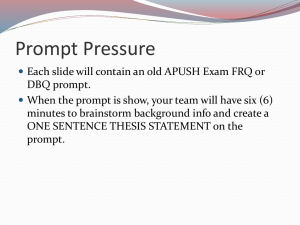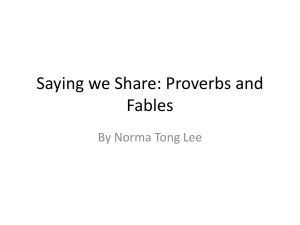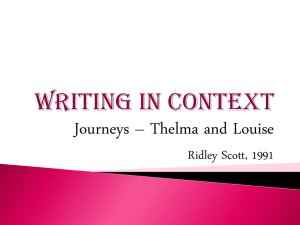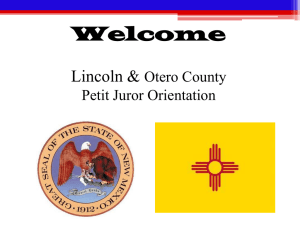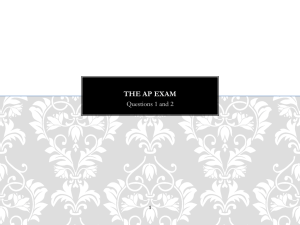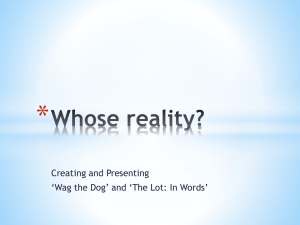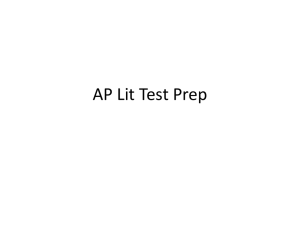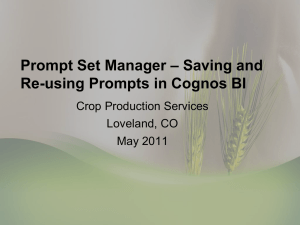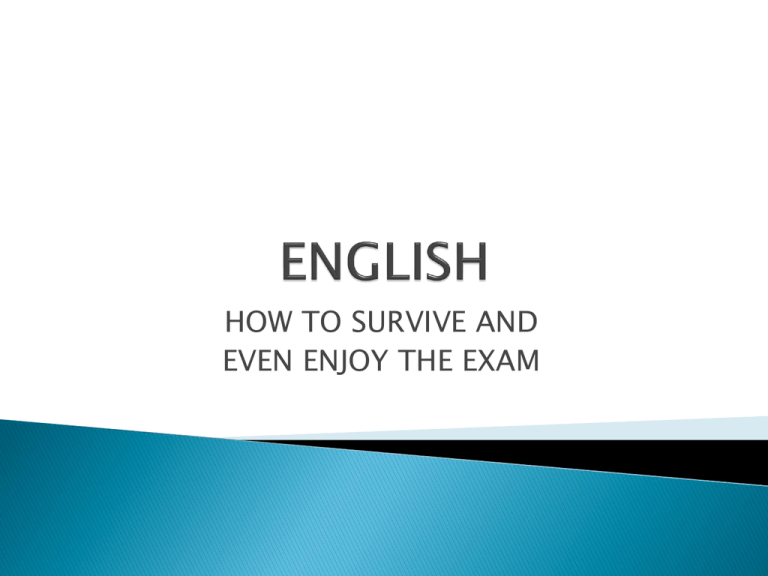
HOW TO SURVIVE AND
EVEN ENJOY THE EXAM
Three hours seems a long time—but it isn’t
Keep to the hour for each section—use a few
minutes to plan—and don’t forget to check
over the work
Do the tasks in what ever order suits you –
just remember to fill in the exam booklet
correctly
Every section is marked by a minimum of 2
markers—so at least 6 people see your
work—it is very fair!!!
Each section has you are looking for a different
skill
Part 1 TEXT—students who “own the text”—ie
people who show they have studied the text in
detail and are able to discuss it in detail
Part 2—CONTEXT—students who show a
sophisticated understanding of the concepts in
the context, who answer the prompt and can
create a piece of writing that shows their
understanding.
Part 3—LANGAUGE ANALYSIS—students who
show how well they can process unseen
information and analyse the way language works
on an audience
Knowledge of the text – how do you show
this?
Use of evidence – includes content and
technique.
Coherence and organisation – does my essay
have a clear contention; have I used TEEL in
my paragraphs?
Maturity, sophistication and insight
Students must indicate
the text and topic on
which their response is
based.
Encouraged to feel confident in your own
reading and interpretation of the text
No expected response to a text
Assessors do not have to agree with your
interpretation
Support your interpretations and claims with
insightful evidence from the text
Don’t ignore the essay question – respond to
it and not to your own!
Analyse all aspects of it – what are the
assumptions being made? Do you agree
completely? Does your agreement need to be
qualified?
◦ “It is only love that changes Terry.” Discuss
Watch out for the little words!
Who are the key protagonists and do we
witness any change?
What are the key relationships? What do they
show about the characters?
What is distinctive about the structural
devices used?
Themes – what is the writer/director trying to
tell the audience?
Levels of Sophistication
Connections-owning and
supporting
interpretations based on
implied values and points
of view
Reflection-Understanding
various interpretations
connected to contextual
features and textual
structures
AcquisitionComprehension of plot,
character, conflict,
themes, language and
images
Propositional
◦ Justice will always overcome prejudice if one
person is brave enough to speak up.” Discuss.
Quotations
◦ “Sometimes the facts that are staring you in the
face are wrong.” Does emotion interfere with the
achievement of justice?
Direct
◦ Why is it so hard for Terry to “tell the truth as he
knows it”?
Respond to all the elements in the question:
Why is it so difficult for the
jury in “Twelve Angry Men” to
reach a verdict?
“demonstrates
an
understanding of the
implications of the topic,
using an appropriate strategy
for dealing with it and
exploring its complexity from
the basis of the text.”(VCAA
website)
“Twelve Angry Men,” a play by Reginald Rose
presents the view that prejudice, personal
feelings and stubbornness restrict our
decisions and the choices that are made. This
is because the jury finds it difficult to reach a
final verdict. Prejudice and personal feelings
blind a juror from the truth and being
stubborn causes the verdict to be prolonged.
7th juror: “Oh Brother!
Anybody got a deck of
cards?” The most
dangerous characters are
the least engaged. Do you
agree?
Step 1
◦ Read the question and underline the keywords
Step 2
◦ Write out alternative words and phrases for the keywords
◦ Remember to think of all the various aspects of a
keywords e.g. suffering
Step 3
◦ Ask yourself what the question means.
◦ What assumptions are being made that you must
address?
Step 4
◦ Formulate your contention
Step 5
◦ Formulate your topic sentences (reasons for your
contention)
Step 6
◦ List the examples you will use for each TS
Step 7
◦ Start writing
Fundamental to the operation and execution of the jury
system, and by extension justice itself, is the concept of
duty and commitment. Disengagement and apathy are
arguably the most dangerous crimes against this system
and are therefore the most damaging. This apathy is
personified in juror 7 in Reginald Rose’s play “Twelve
Angry Men.” His character is portrayed as the most
detrimental to their process of deliberation. He has “had
enough” of the case from the start, more concerned with
being on time for his ball game than the outcome. This
prevents the most fair and accurate outcome and also
jeopardises the fairness of the system they are
representing. Although juror 3’s aggression and juror
10’s bigotry are also highlighted as extremely dangerous,
juror 7’s inability to care has the deepest moral
implications.
Initially, the aggression from juror 3 is at the forefront of the negative
traits in the jurors. He calls the defendant a “rotten kid” immediately
and attempts to convince the men throughout the play that the young
man will “be found guilty as sure as he’s born” regardless of their
personal beliefs about his guilt. The audience resents his loud,
opinionated views because, like the 8th juror, we recognise the personal
bias and anger behind those views from the start, thus his irrelevant
commentary. As juror 3 ironically states, “there are no secrets in a jury
room” and eventually his motives emerge in the open. However, juror
3’s opposition and heated involvement throughout can be seen as active
involvement in the deliberation. Despite his largely negative take on the
whole case, at least he is making a concerted effort to decide the fate of
a teenage boy. Juror 8 opens by suggesting they “owe [the boy] a few
words” and it is for this very reason that the actions of juror 3 are
dangerous but ultimately his own twisted version of reality – the nature
of the jury system means that you are entitled to “unpopular opinions.”
We can therefore accept s “wrong” opinion over no opinion at all.
Furthermore, we eventually feel sympathy for juror 3 and the heartache
his son had out him through – it would be an exaggeration to therefore
describe his actions and opinions as dangerous.
Power & corruption
Forms of power
Power as knowledge
Redemption
Morality
Individual conscience
Faith/Christian symbolism
Goodness
Working class life
- Fog
- Joey’s jacket
- Pigeons and hawks
- Christian symbols
- Hook
Rule of law - Law and justice and the
failure/success of the jury system
Civic duty and social responsibility
the individual and integrity - taking a stand
◦ Internal conflict and decision-making
◦ Courage is essential in taking a stand
Obstacles to justice
◦
◦
◦
◦
◦
◦
Prejudice and racism
Apathy and disengagement
Ignorance
Lack of responsibility
Fallibility of memory
Fact vs fancy
The individual is crucial in the achievement of
justice - all individuals must carry out their
civic duty and social responsibility.
Prejudice, racism, stereotypes, fallibility of
memory, fact vs fancy, all have the potential
to undermine the justice system.
Role of the judge
Locking of the door
Scarred table
Weather – heat, storm, subsiding of
the storm
Broken fan
Summarise the text
Leave out CAMELS/stage directions
Start a paragraph with an example
Start your conclusion with “In conclusion…”
Use the same example more than once
Leave out aspects of the question
Reuse key words repeatedly
Panic if the question looks really complex –
just start breaking it down.
Writer/director’s purpose/message
How this message is conveyed to the
audience
The key characters
Changes and relationships in relation to these
characters
Intro
◦
◦
◦
◦
contention
Explanations of keywords
Alternative words to keywords
Scope
Body (3)
◦ TEEL; topic sentence, explanation,
evidence/examples and link
Use a variety of words to show you make
good language choices
Demonstrating/indicating/a reflection of
The use of ….
Therefore demonstrating that….
The notion of……is valued above…..
The director’s/playwright’s interest in the theme of
.....is expressed through the experiences of
(character’s name)
◦ A recurring symbol in the text is ......which is
associated with.....
◦
◦
◦
◦
◦
The film/text endorses the values of.....
The director uses ……(techniques) to convey the
idea/point that...
While (name of text) suggests that...., it also
suggests that....
Kazan/Miller challenges the stereotypes…..
Kazan/Miller deliberately constructs…
Kazan/Miller is alluding to…
Kazan/Miller interweaves…
Know your text inside out –live, breathe, eat
it.
◦ Evident in your ability to give evidence (content and
technique) for all the claims you make
Know the structure for your essay
Are you able to analyse the essay question
accurately?
Practice, practice, practice – full pieces and
plans (contention, TS and examples for each
TS)
What to remember for the exam!
No statement of intention-show what you are
trying to achieve
Must make connection to the text more
obvious as no SOI
Only one prompt for 4 very different texts
Could be a visual prompt
Quality of
Writing
Quality of
ideas
Handling of
the prompt
Examiners are looking for
Students who are able to explain the BIG PICTURE behind
the prompt and use the prompt effectively
Students who have thought about the context and are able
to use examples to support/illustrate/illuminate their
ideas
Students who can write clearly, coherently and fluently
“Students must respond to the prompt. While a prompt
can be seen as a springboard for ideas in relation to the
context, the piece of writing must deal with the ideas
the prompt itself offers. The most successful scripts
showed insight into the implications of the prompt.
Some students ignored the prompt completely.”
Ideas...showing depth and breadth in your
exploration of significant conceptual ideas and
thinking and a conceptual link to your text(s)
Writing...demonstrating your ability to use
language effectively and accurately
Prompt...a clear link to the prompt is shown in
your work
Remember it is ENCOUNTERING CONFLICT—
not just conflict so therefore it is about how
people react and respond to conflict
So make revision notes with examples for
Causes of conflict and the types
What is needed to survive conflict?-(survive is
not live)
Consequences of conflict –
For individuals/families/relationships
Communities
Societies/world
Can I use outside information? Is it checked?
Do creative responses earn more marks than expository?
Can I refer to a Part 1 text such as 12 Angry Men which would
suit this context?
Do I need to use quotes?
Should I use more than one text as the basis of my piece?
Can I use ideas I have put in an essay before?
About use of text
“While this is a clear instruction that the text drawn from must
inform the writing in ways that must be clear to the reader and
that the student has used it effectively “ as appropriate to the
task”.
In the examination students who compose seemingly gratuitous
creative pieces or simply label one of their characters ‘Abigail’,
‘Blanche’ or ‘Holden’ have not fully examined or explored the
ideas of the text in relation to the prompt. They must ensure that
the connection between the piece of writing and the nominated
text is discernible and central in the ideas of their pieces.
The most successful responses drew thoughtfully from the text;
however, the least successful only used a scene or a feature of
character in a superficial way or retold the plot of the text.
(Assessment reports 2010, 2011 –VCAA website)
About examples
Students who used more than one source to
illustrate their ideas often produced pieces
with a strong sense of unity and purpose.
This cohesiveness was contrasted by pieces
where one idea followed the next as students
went through their list of examples. The
product was more a plan for an essay than a
thoughtful, finished piece.
9–10
• Demonstrates an insightful grasp of the implications of the prompt/stimulus material, and perceptively
explores its conceptual complexity using an appropriate strategy for dealing with it.
• Achieves an assured, cohesively structured piece of writing in an appropriate form, successfully
integrating, in a sophisticated way, ideas suggested by the selected text(s).
• Makes fluent and effective use of language.
8
• Demonstrates an insight into the implications of the prompt/stimulus material and explores its
complexity using an appropriate strategy for dealing with it.
• Achieves a controlled, cohesively structured piece of writing in an appropriate form, effectively using
ideas suggested by the selected text(s).
• Makes fluent and confident use of language.
7
• Demonstrates a clear understanding of the prompt/stimulus material, and the ability to explore some of
its ideas, using an appropriate strategy for dealing with it.
• Achieves a coherent piece of writing in an appropriate form, making some use of ideas suggested by the
selected text(s).
• Uses language accurately and appropriately.
6
• Demonstrates an understanding of the prompt/stimulus material and is able to work with some of its
ideas, using an appropriate strategy.
• Presents a generally organised piece of writing, in an appropriate form, drawing on ideas suggested by
the selected text(s).
• Uses language adequately and appropriately.
5
• Demonstrates an understanding of the prompt/stimulus material, and the ability to respond to some of
its ideas.
• Presents a piece of writing with some organisation, demonstrating some understanding of ideas
suggested by the selected text(s).
• Uses language adequately and appropriately.
4
• Demonstrates some understanding of the prompt/stimulus material, and the ability to respond to it.
• Presents a piece of writing with limited organisation and limited reference to the selected text(s).
• Shows adequate language control.
“New environment creates conflict.”
(Causes of conflict)
Intro 1--Individuals, seeking for greener pastures, will often be
exposed to new and unfamiliar surroundings that will ultimately
cause disagreement to arouse. Often at times, asylum seekers
will tend to resent living with other races due to different habits
in terms of decision-making, cultural superstitious or beliefs. It
mostly leads to arguments. Also, refugees and asylum seekers
will find it hard to adopt new surroundings and language
barriers. Sometimes, others may not at all overcome the conflict
because most prestigious organisations prefer to employ people
with English-oriented backgrounds for better profitability. Most
asylum seekers or refugees will also have an unfair treatment
and will be subjected to racism. Migrants will always encounter
difficulties and obstacles in quest for a better and liveable
surrounding as long as racism is globally alive and well.
Intro 2--Conflicts arise from new environments where people
are unfamiliar and do not know how to handle new cultures
and lifestyles. In the novel, Rugmaker of Mazar-e-Sharif, Najaf
fled his homeland of Afghanistan to escape the threats of the
Taliban but found himself in a land that forced him to question
his decision. He struggled alone as he did not understand the
language or the practices of Australia. Conflict itself derives
from our individual differences and it is for that fact that it is
an inevitable part of our existence. When our needs for
appreciation are not being fulfilled in our relationships, we
experience relational conflict because others do not see us in
the way we wish to be seen. For example, older employees may
be upset if newer co-workers do not give them respect for the
wisdom that comes with their years of experience. In Arthur
Miller’s play, The Crucible, a group of girls are led by Abigail
Williams on a witch hunt where they find themselves in
uncomfortable and threatening surroundings, forcing them to
pursue untrue accusations which results in interpersonal
collisions. When our feelings clash with others’ feelings, we are
in conflict and this can often be caused by new and unfamiliar
environments.
“Conflict can be a catalyst for change.”
(Consequences of conflict)
Intro 1--Most people tend to think that conflict is a bad
thing, however, if it is managed properly, positive
outcomes can be produced. Struggles of any kind can be
positive when they encourage creativity, new looks at old
conditions, the clarification of points of view, and the
development of human capabilities to handle interpersonal
differences. Alternatively, conflict can be negative when it
creates resistance to change, establishes chaos in
organizations or when interpersonal relations foster
distrust. Despite these possibilities, conflict is a facilitator
of change and is a necessary process through which
decisions are made. Some of the positive outcomes of
conflict are that better ideas are produced by interacting
and sharing of thoughts so new approaches are realised,
individual views are clarified by being open, long standing
problems are brought to the surface and resolved by
having good communication and understanding, creativity
and interest are increased by compiling ideas and interests,
and one’s capacity can be tested.
Intro 2-When dealing with difficulties and hardship, some of us
might tend to change the approach or procedure to
maximise and overwhelm these conflicts. In Rugmaker of
Mazar-e-Sharif, it is after witnessing the full wrath from
the hands of merciless Taliban’s that Najaf decided to flee
Afghanistan and head course for a safer and liveable
condition. After having learnt of the 09-11 bombing,
George Bush didn’t hesitate in closing the American
borders from other countries and consistently change into
a more secure-conscious state. After Nelson Mandela
served 27 long years of imprisonment for conviction of
sabotage, he finally made a dedicated decision and later
became a successful man who represented as the president
of South Africa. It is indeed that our obstacles that we face
can help mould our decision and help us seek change in
once approach.
It may seem that our everyday lives are filled with
mundane routine, however we eventually realise
that every relationship, every commitment
gradually becomes a significant part of who we
are and how we see the world.
The ultimate power of ‘family’ is to shape who we
are and how we see the world.
It’s said that we can only live our lives forward
but only understand them in reflection.
Really understanding our past is essential to
living a satisfying life.
Add 3 more sentences to each of these,
discussing and exploring the idea of the topic
sentence
Write a subsequent paragraph which explains
and explores how a ‘quote’, scene, event
from your text illustrates what you’ve said.
Or…begin an anecdote or story which will
pursue this idea
Or…simply expand the discussion you’ve
begun about identity and belonging
may have
but
and
interestingly
eventually
finally
apparently
however
whilst
if, in fact
if
despite
ultimately
but, in fact
as well as this
although
perhaps
in some cases
You have to be able to:
“Analyse and compare the ways in which
verbal and non-verbal (including visual)
language…is used to persuade readers and
viewers to share the point/s of view being
presented.”
An understanding of the ideas and points of
view presented
An analysis of ways in which language and
visual features are used to present a point of
view and to persuade readers
Controlled and effective use of language
appropriate to the task
High Level Responses:
Show a perceptive and sophisticated
understanding of a range of ways in which
the written and visual language positions
readers in the context presented.
Develops a cogent, controlled and wellsubstantiated analysis using precise and
effective language and expression.
2010 Exam:
Appealing to the readers’ sense of social justice, Lee reminds
the audience why biological diversity is ‘so important’ in
protecting the living standards of the ‘poor’. Highlighting how
reduced genetic variation and increased biological similarity
within ecosystems will impinge upon ‘food security’, ‘nutrition’
and the health of the ‘rural poor’ in exacerbating ‘extreme
poverty’, Lee asserts that it is our humanitarian duty to ensure
that such injustice is not inflected upon our fellow human
beings. Metaphorically presenting ‘us’ Westerners as the
‘powerful economic giant’ and callous ‘affluent hunters’
‘subordinating’ the interests of the poor to pursue personal
wealth and ravish the environment, Lee urges us to ‘hunt less,
gather less and preserve more before it is too late’, effectively
summarizing the crux of his argument into a useful repetition
of metaphor. By evoking imagery in the reader with ‘us’ – the
affluent, greedy giant, insatiably destroying habitats and
marginalising the livelihood of the third world, the reader’s
sense of justice and righteousness is inflamed to urge
compliance to Lee’s contention.
The basis on which the piece has been
created. What is it that the presenter is
trying to achieve? What might you
expect from this person?
Context
Contention
The construction of
the piece. Where the
reader is being led.
The specific language – the
selected words and phrases
to effect a particular
purpose.
The basis on which the piece has been
created. What is it that the presenter is
trying to achieve? What might you
expect from this person?
Context
Contention
The construction of
the piece. Where the
reader is being led.
The specific language – the
selected words and phrases
to effect a particular
purpose.
It is safe to say that no writer randomly puts down
his thoughts and ideas when presenting a point of
view.
Therefore you must consider how the construction
of a piece is adding to its impact – where it is
leading the reader or listener.
Your task is to identify that construction and to
analyse the way it adds meaning to the piece in
terms of its persuasiveness.
WHAT ARE THE SPECIFIC WORDS,
PHRASES AND IMAGES THAT THE
WRITER USES IN ORDER TO CREATE A
PARTICULAR IMAGE OR FEELING?
WHY HAS HE CHOSEN THAT WORD OR
IMAGE?
COLOURS BEST DEMONSTRATE THE
CONCEPT OF CONNOTATION
DENOTATION
CONNOTATION
RED
PRIMARY COLOUR
WHITE
ALL COLOURS
COMBINED
SOCIALISM, STOP, ANGER,
HOT, SEX
PURITY, CLEANLINESS,
WHOLESOMENESS (MILK)
BLACK
ABSENCE OF COLOUR
EVIL, FEAR, DEATH
GREEN
SECONDARY COLOUR
BLUE& YELLOW
ENVIRONMENT, ENVY,
FERTILE, ILL
YELLOW
PRIMARY COLOUR
COWARDLY, CAUTION
PINK
SECONDARY COLOUR
RED & WHITE
FEMALE
How to write a strong analysis:
Step 1: Use your reading time wisely!
Read all materials thoroughly (including the
background information)
While reading consider:
- The point of view that is presented
- The arguments presented to support this view
- The language choices intended to persuade the
audience
Step 2: Take a few moments to plan
As soon as writing is allowed, use a
highlighter or pen and identify on the page
the key aspects that you think should be
addressed in your analysis.
(Remember: You cannot analyse every line in
the piece and there is no expectation that you
do!)
Step 3: Structure your analysis logically
-
Provide a succinct introduction
Use the key arguments that you have identified to
give your analysis purpose.
What is the argument?
How has written and visual language been used to
persuade the audience to agree?
To conclude- Keep it simple!
Hint: Save the closing statement and analyse this.
What final thoughts does it provoke in the target
audience?
Sample Introduction:
Keynote speaker at the 2010 international Biodiversity
Conference, Chris Lee, speaks with conviction to
conference attendees; most of whom are involved in the
area of nature conservation. He contends that action must
be taken to safeguard the variety of life, or, biodiversity.
Alternating between an accusatory and disapproving tone
and one of alarm, the two complement each other and are
utilised to successfully persuade the speaker’s powerful
and influential audience to take action to preserve
biodiversity. The use of a visual aid in the form of a slide
presentation assists the speaker, presenting the argument
through a different medium.
Sample Conclusion:
Lee ends with a final call to action with the image of
the world being held by human hands. By depicting
the world as being in ‘our’ hands, Lee is calling on
the audience to reinforce and pass on the message
to everyone. The world, is in essence, relying on the
conference attendees to care for it and ensure its
safety and ensure biodiversity, our ‘greatest
treasure’ is not diminished ‘at all costs.’ Ending with
a visual allows the audience to ‘see’ the argument
Lee is presenting. In doing so, the audience is able to
be persuaded of Lee’s conviction that the
safeguarding of biodiversity is vital, and also
reinforces to the conference attendees that they
need to take action.
Step 4: Make well considered language choices
Vary language choices when exploring effect:
-
The writer positions…
Readers are manipulated/convinced to…
It is implied…
(writer’s name) alludes to…
Lures the reader…
Casts doubt on…
Forces readers to…
Exploring the writer’s intention:
-
-
Provokes controversy
Generates debate
Identifies with
Empathises with
Indicates
Expresses
Shows
-
Focuses on
Inspires
Intends to
Highlights the significance of
Reinforcing
Enforcing
Fosters a sense
-
Revisit TONE words:
Passive
Angry
Excited
Sympathetic
Authoritative
Questioning
Condescending
Facetious
Proud
Encouraging
-
Brash
Wistful
Aggravated
Light-hearted
Humorous
Calm
Sarcastic
Harsh
Disgusted
Arrogant
RESPONDING TO A VISUAL
3 ‘C’s’- Big picture- your case
Selected detail, connections-Be the expert
Cohesion , editing and completion
Final Tips:
Pay attention to the background information. It is important
to understand the context of the piece.
Ensure that you ANALYSE rather than just SUMMARISE (Focus
more on how information is presented rather on what is
presented)
Focus on the tone. Why is it being used and how does it
change throughout?
Explore how the visuals add to the persuasiveness of the
written material.
Litter metalanguage throughout to show that you
understanding the choices being made. (Don’t turn it into a
shopping list!)
Practice! Practice! Practice!
What to do for the remainder of 2013 for Language
Analysis
•Listen all around you to the way language is being used –
‘normalise’ the task
•Become familiar and comfortable using ‘your language of
analysis’
•analyse the photo / letters section of The Herald-Sun, The Age....
•Never passively view or listen to an ad – they provide wonderful
opportunities for working on analysis
•Work on ‘different’ types such as brochures, ‘how to vote cards’, visual
displays
•Study various forms of visual material: cartoons, pictures, drawings,
paintings, images
•BE THE EXPERT
GAFFS FROM THE ENGLISH EXAM 2009-12
Awquidness
Marriage vowels
A tartoo
Iminate death
Martyrdom inevitably leads to death
Sam uses hypathetic questions
The fowl behaviour of parents
Situation of life and deaf
The writer ultimately commences their piece with…
They soon realised war isn’t an easy battle
All my experiences lie in sheep
I have a few heroes like Martin Luthor King and the Lion KiNG
Gives enforsus
Robert Frost poetry is poetry worth reading
The actions of Hitler disregarded the good of smaller entities in order to achieve a greater good
He refers to the Olympic runner who stopped to help his rival. This is wrong I can’t recall the runner.
The anecdote appeals to the reader’s motions
Petrol prices are likely to be conflicting with your income
All that both died and survived
To Aborigines the land is a holly place
Inclusive language helps Sam in reeling people into his boat
In the French Revolution So many people lost their heads you couldn’t take 3 steps without standing on a body.
Rhetoicle, rhytoical,rhetorical,rytorical, etc
The boy had a low self of steam.


